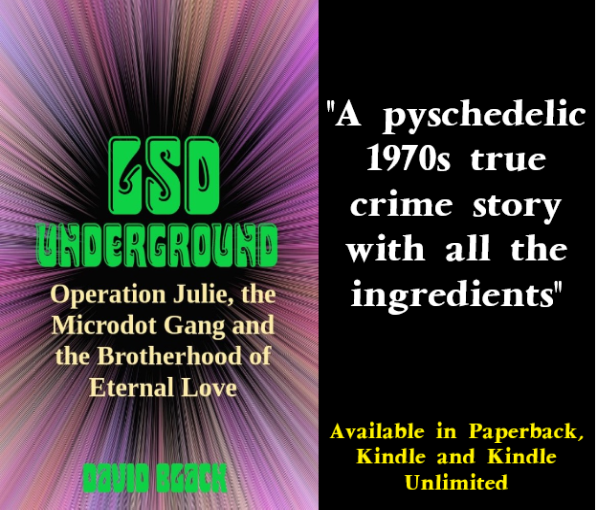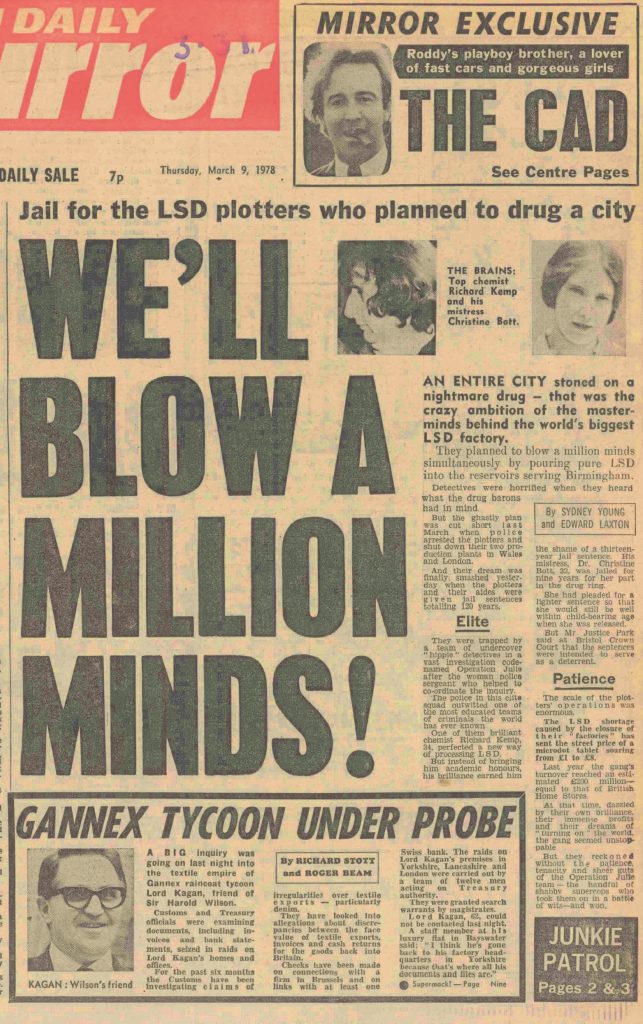
LSD Underground: Operation Julie, the Microdot Gang and the Brotherhood of Eternal Love by David Black is available in paperback for £9.99 at Amazon (£4.99 Kindle edition – free on Kindle Unlimited). You can read the preface and contents for free below: \/
Preface
Whilst on remand in Her Majesty’s Prison Bristol, in 1977, Leaf Fielding, LSD distribution manager, met LSD chemist, Richard Kemp:
“Richard was a man after my own heart. We talked long and excitedly in one-hour bursts. He too had wanted to turn the world on and he’d gone a long way towards achieving his aim by producing kilos of acid, enough for tens of millions of trips…
‘And look where our idealism got us.’
His despondently waving arm took in the prison walls, D wing and the punishment block.
‘Well we’re not the first people to be persecuted for we believe in,’ I replied, ‘and I don’t suppose for a moment we’ll be the last. We’ll be exonerated in the future, don’t you think?’
‘Maybe. But that doesn’t help us now.’
The bell brought another exercise period to an end.”
Leaf Fielding, To Live Outside the Law
LSD Underground, the title of this book, refers to the British producers and distributors of Lysergic Acid Diethylamide (LSD) who began operating in 1968 and continued in secret for nearly a decade. The venture grew into an underground industry, supplying the festival-going youth of the 1970s with tens of millions of acid trips. The police eventually rounded up most of the gang’s principals in March 1977 in what the media hailed as the ‘biggest drugs raid in British history’. On 8 March 1978, at Bristol Crown Court, 29 defendants were handed down prison sentences totalling 170 years, with the sentences for the 17 principal defendants amounting to 133 years.
The first issue in writing about the defendants in the Operation Julie trial is what to call them. They have been referred to as the ‘Microdot Gang’, but this is a misnomer, because a split in 1973 produced two separate and independent organisations which shared a common origin. The LSD conspirators have also been called the ‘Operation Julie Gang’; but that is anachronistic because it wasn’t until 1976 that the police launched Operation Julie. Hence I will use the term, LSD Underground, which is more accurate and descriptive.
The present work follows several books that have appeared since the Julie trial in 1978. Three books have been written by former police officers of the Julie squad: the operational commander, Richard Lee, and undercover detectives, Martyn Pritchard and Stephen Bentley. Two books have been authored by defendants: Leaf Fielding, LSD distributor; and Christine Bott, lover of the LSD chemist, Richard Kemp. Alston ‘Smiles’ Hughes, another defendant, who distributed acid from his base in Llanddewi Brefi, Wales, is currently working on his memoirs in collaboration with Andy Roberts, which will be published sometime in 2022. Stewart Tendler and David May’s book on the US Brotherhood of Eternal Love deals at length with that organisation’s relations with their British counterparts. Lyn Ebenezer’s book on Operation Julie gives the perspective of a local journalist covering the story in Wales (all these books are listed in the bibliography).
Why another book? Simply because, whatever the merits (which are many) of the above published books, some of them suffer from factual inaccuracies which can now be corrected with what historians refer to as ‘updated scholarship’; and none of them present an adequate blow-by-blow account of the genesis, development and downfall of the LSD Underground in the years 1968 to 1978. Detective Inspector Richard Lee’s book Operation Julie, How the Undercover Police Team Smashed the World’s Greatest Drugs Gang attempts to make sense of the British LSD Underground as part of an international conspiracy rooted in the US Brotherhood of Eternal Love, which is described by Stewart Tendler and David May as a ‘hippie mafia’. The international dimension of the LSD producers needs to be explored further and more thoroughly. Here, I attempt to unravel and demythologise it.
One of the challenges any writer presenting this history has to deal with is the age-old problem of participants offering differing accounts of the events and their interaction with each other. These accounts are often motivated by self-justification or simply the wish to tell a good story. It is necessary therefore to be sceptical on the one hand of the ‘official’ agenda which called to account those who broke the law and supposedly threatened public morality; and on the other hand the counter argument that the ‘acid adventure’ was a noble cause which just happened to be illegal – and lucrative. Corroboration – or rebuttal – has been employed whenever possible and in appropriate measure.
Operation Julie exposed a war of ‘values’ between the agencies of the state and its ascribed enemies in the counterculture. The LSD Underground conspirators were committed to changing mass consciousness through psychedelic enlightenment, but their ‘idealism’ rapidly gave way to the exigencies of running an organised crime group. Although as hippies they nominally rejected violence, one of the first things that struck the police investigators was that the organisational structures resembled the sophisticated cell-networks of terrorist groups, involving the use of aliases, secret bank accounts and safe deposit boxes, front companies, dead-letter drops, messages in code, and the like; hence the confusion that wracked the police investigation. I argue that the police, media and state had little understanding of what they were up against.
The reader of whatever opinion will find heroes and villains in this tale. The hippies were plagued by cheating, informing and paranoia; the police by corruption, bureaucratic incompetence and internal rivalry. This historical narrative investigates the motives and practices of the British LSD Underground and its American cohorts. It also shows how Operation Julie was weaponized in a culture war to suppress ‘deviation’ from ‘traditional’ values which a victorious Thatcherism came to represent in the ensuing years. Ultimately, however, it was a pyrrhic victory over the counterculture and in the ‘War on Drugs’.

